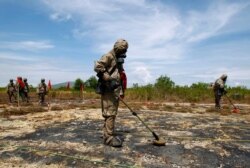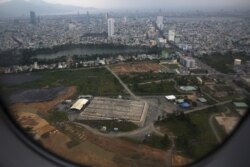Vietnam has handed over an area of land to its former war enemy the U.S., but this time the two sides aren’t fighting across an old battlefield, but working together to fight what lies beneath.
What lies beneath are the remnants of Agent Orange, the chemical that U.S. forces sprayed across this country to destroy tree cover in the Vietnam War. Now Vietnam is handing over 37 hectares of land outside Ho Chi Minh City to the U.S. temporarily to remove the chemical, which has been linked to cancer and other diseases, birth defects, and environmental destruction.
Officials from both nations participated in an official handover ceremony Friday in Hanoi, before starting on the clean-up project in southern Bien Hoa city.
“The Bien Hoa Airbase, the primary Agent Orange storage and handling site during the U.S.-Vietnam War, is the largest remaining hotspot of dioxin contamination in Vietnam,” the U.S. embassy in Hanoi said in a statement. It said this marks the latest in a general effort “to cooperate on the humanitarian mission of accounting for personnel still missing from the war, and resolve wartime legacy issues including the removal of unexploded ordnance, support for persons with disabilities, and the remediation of dioxin.”
Even as the U.S. has tried to make up for its intervention in a war opposed by many, there are limits to its reparations. The War Legacies Project, an advocacy organization for Agent Orange victims, supports the clean-up but says the U.S. doesn’t do enough to help Vietnamese still hurt by exposure to the chemical contamination.
“The U.S. government continues to be hesitant to specifically support for those believed by the Vietnamese to be impacted by Agent Orange/dioxin,” the organization said on its website. While Washington has provided funding to U.S. veterans hurt by Agent Orange, it has rejected Vietnam’s claims that the chemical causes cancer, deformed limbs and spines, and other harm.
Around the Bien Hoa area, the Vietnamese government and the U.S. Agency for International Development determined that there are 500,000 cubic meters of land contaminated by dioxin. That represents four times as much contaminated land in the central city of Da Nang, which is where U.S. forces first entered the country in intervening in the Vietnam War in 1965.
The clean-up of the Da Nang Airport area cost $110 million and six years.
USAID has agreed to spend $183 million for the first five years of the Bien Hoa clean-up, estimated to require 10 years.
Although the latest clean-up is moving ahead, it is not likely to be the end of the story. Observers are waiting to see when the Vietnamese President Nguyen Phu Trong will make an official visit to Washington, expected to be by the end of the year. And issues about the Vietnam War will probably be on the agenda, Carl Thayer, emeritus professor with the University of New South Wales in Australia, said.
“Vietnam will press the United States to continue to address war legacy issues,” he said, “such as Agent Orange or dioxin contamination and disposal of unexploded ordnance.”








